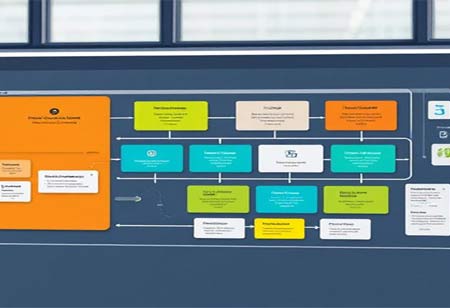THANK YOU FOR SUBSCRIBING
The Rise of Workflow Automation in APAC

By
Apac CIOOutlook | Monday, May 26, 2025
Stay ahead of the industry with exclusive feature stories on the top companies, expert insights and the latest news delivered straight to your inbox. Subscribe today.
Business workflow automation has become a critical enabler of efficiency, productivity, and innovation across Asia-Pacific (APAC) organizations. Companies across various industries and scales leverage advanced technologies to streamline processes, optimize workloads, and enhance collaboration. As a cornerstone of the Fourth Industrial Revolution, business workflow automation drives operational excellence and empowers organizations to prosper in an increasingly digital economy.
Rising Trends in Business Workflow Automation
The rapid adoption of intelligent automation in the APAC region is transforming workflow management by integrating artificial intelligence (AI), machine learning (ML), and robotic process automation (RPA). Businesses increasingly deploy intelligent bots to streamline repetitive tasks such as data entry, report generation, and resource scheduling. Additionally, AI-powered analytics enable decision-makers to extract actionable insights from vast datasets, remodeling operational efficiency and strategic planning.
The shift toward hybrid and remote work models, accelerated by global disruptions, has further driven the need for advanced workflow automation solutions. Organizations are leveraging cloud-based automation platforms and real-time workflow visualization tools to facilitate seamless collaboration across distributed teams, ensuring operational continuity and productivity regardless of physical location.
Another key trend shaping workflow automation in APAC is the rise of low-code and no-code platforms. These solutions democratize technology access, empowering non-technical users to design and implement workflow automation without requiring extensive programming expertise. These platforms significantly reduce development cycles and enhance agility by enabling businesses to adapt workflows to evolving market demands rapidly.
Furthermore, integrating the Internet of Things (IoT) into automation workflows unlocks new operational efficiency levels. From automating supply chain logistics to optimizing energy consumption in smart buildings, IoT-driven automation enhances visibility and control over business processes. Sensors and connected devices seamlessly communicate with automation software, creating intelligent, responsive, and adaptive workflows that drive innovation across industries.
Industry-Specific Adoption in Workflow Automation
Workflow automation drives significant transformations across various industries, enhancing efficiency, accuracy, and service delivery. Automation streamlines customer service, fraud detection, compliance, and back-office operations in banking and finance. It accelerates credit approvals, optimizes customer onboarding, and ensures precise financial reporting. Similarly, in healthcare, automated workflows are improving patient data management, appointment scheduling, pharmaceutical supply chains, and claims processing. Healthcare providers can allocate more resources to patient care by reducing administrative burdens.
In the retail and e-commerce landscape, particularly in the APAC region, businesses leverage automation for inventory management, personalized marketing, customer service, and demand forecasting. These innovations enable companies to enhance profitability while meeting consumer expectations for faster, tailored services. Meanwhile, manufacturing in APAC is undergoing a paradigm shift with Industry 4.0, where automation is revolutionizing production processes, improving precision, enhancing safety, and minimizing waste. Technologies such as robotics and digital twins are redefining assembly lines and quality control.
Governments and public service entities also embrace automation to enhance efficiency and transparency. Local authorities are leveraging automated solutions for document processing, citizen engagement, and service delivery. By digitizing routine tasks, workflow automation fosters seamless interactions between governments and the public, ultimately improving governance and accessibility.
Regional Insights in Workflow Automation
East Asia remains a global leader in automation technologies, with China, Japan, and South Korea making significant investments in AI, 5G networks, and robotics. These advancements are fostering the development of sophisticated workflow automation solutions across various industries. In Southeast Asia, nations such as Singapore, Malaysia, and Indonesia rapidly emerging as key players in digital transformation. Both government initiatives and private sector investments are driving automation in critical sectors, including logistics, healthcare, and banking, to enhance economic growth and global competitiveness. Meanwhile, South Asia, led by India’s expanding IT services sector, is embracing workflow automation to optimize business process outsourcing and domestic operations, with neighboring countries gradually adopting similar innovations tailored to their unique market needs. In Australia and New Zealand, automation is leveraged to address labor shortages and boost productivity. These nations are also at the forefront of integrating sustainability-focused workflows, incorporating renewable energy solutions, and resource to drive efficiency and environmental responsibility.
Technologies Driving Automation
Cloud computing and Software-as-a-Service (SaaS) models are transforming business operations by enabling the deployment of automation tools without significant upfront investments. The SaaS model, in particular, remains a preferred choice due to its scalability and real-time updates, ensuring seamless workflow automation. Meanwhile, artificial intelligence (AI) and predictive analytics enhance automation by optimizing workflows and proactively adjusting processes to mitigate potential disruptions, ensuring operational continuity. Blockchain technology also makes inroads into workflow automation, providing secure and transparent execution of critical processes such as supply chain tracking, contract enforcement, and payment settlements. Additionally, robotics, equipped with advanced sensors and control systems, are revolutionizing manufacturing, logistics, and healthcare industries, delivering high precision and unparalleled efficiency in process execution.
Workflow automation provides various strategic benefits, including enhanced operational efficiency, cost reduction, and employee engagement. Organizations are increasingly adopting automation to minimize human errors, ensure compliance with regulatory requirements, and identify new revenue opportunities. Additionally, automated workflows facilitate seamless interdepartmental collaboration and support agile decision-making.
Automation technologies are set to play an increasingly vital role in advancing sustainability across the APAC region. Leveraging AI-powered analytics and IoT-driven operations, the next wave of innovation will unlock unprecedented opportunities for sustainable growth. Organizations that embrace this transformation will ensure regulatory compliance and strengthen their competitive position in the market.
The outlook for workflow automation in the APAC region remains highly promising. With increasing investments in artificial intelligence, cloud computing, and the IoT, automation technologies are expected to become more accessible and adaptable. As businesses prioritize efficiency and innovation, adopting automated workflow solutions will accelerate, reinforcing their role as a fundamental driver of digital transformation.





